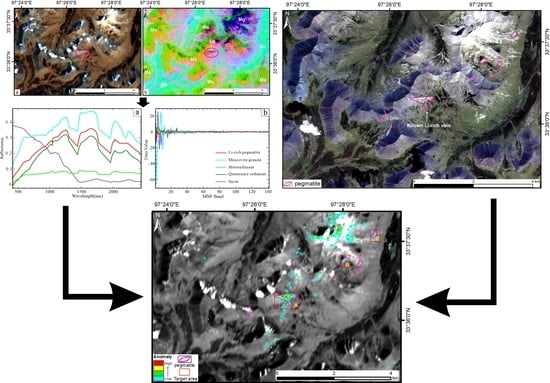Lithium-Rich Pegmatite Detection Integrating High-Resolution and Hyperspectral Satellite Data in Zhawulong Area, Western Sichuan, China
Abstract
:1. Introduction
2. Study Area and Geological Setting
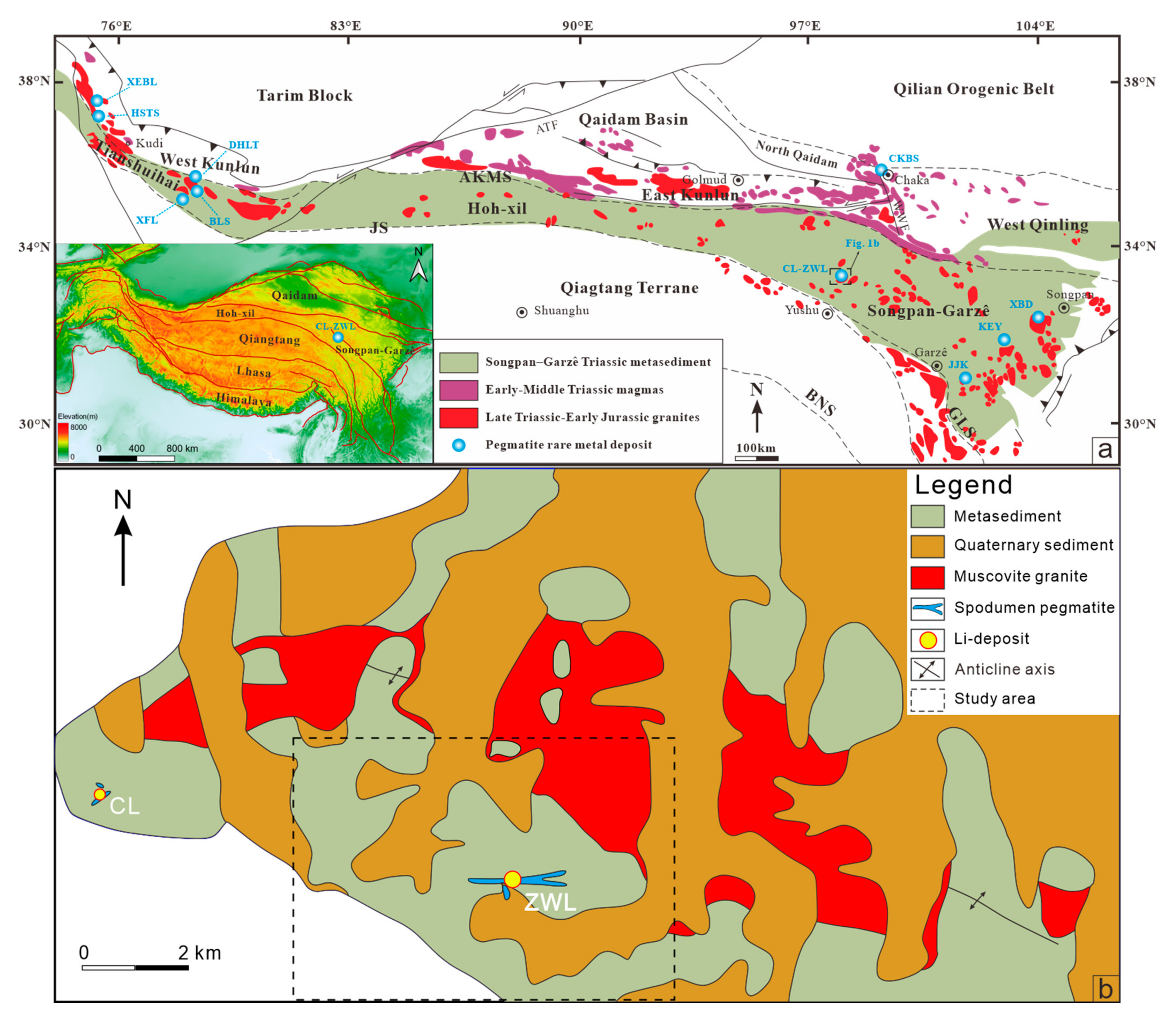
3. Materials and Methods
3.1. Data Pre-Processing
3.1.1. GF-2 Satellite
3.1.2. ZY1-02D Satellite
- (1)
- Spatial subset to research area and removal of overlapping, water vapor, strip and noise-evident bands (i.e., B1-B2, B77-B79, B96-B102, B124-B133, B164-B166). The remaining 141 bands were used for subsequent analysis;
- (2)
- Conversion of digital number (DN) value to radiance through radiometric calibration;
- (3)
- Correction of radiance data to reflectance by using the FLAASH module in ENVI;
- (4)
- Orthorectification using a Landsat-8 scene as a reference image by “RPC Orthorectification Using Reference Image” tool in ENVI;
- (5)
- Geographical registration with the GF-2 image. The spatial registration accuracy (RMSE < 1) has been visually verified to meet the requirements of the research.
3.2. Methods
3.2.1. Constrained Energy Minimization (CEM)
3.2.2. Adaptive Cosine Estimator (ACE)
3.2.3. Spectral Angle Mapper (SAM)
3.2.4. Spectral Angle Mapper with BandMax (SAMBM)
4. Results
4.1. Pegmatite Delineation
4.2. Li-Rich Pegmatite Anomaly Detection
4.2.1. MNF Transform Results
4.2.2. Target Detection Results
5. Discussion
6. Conclusions
Author Contributions
Funding
Data Availability Statement
Acknowledgments
Conflicts of Interest
References
- Bradley, D.C.; Stillings, L.L.; Jaskula, B.W.; Munk, L.; McCauley, A.D. Lithium. In Critical Mineral Resources of the United States—Economic and Environmental Geology and Prospects for Future Supply; Schulz, K.J., DeYoung, J.J.H., Seal Ii, R.R., Bradley, D.C., Eds.; U.S. Geological Survey: Reston, VA, USA, 2017; pp. K1–K21. [Google Scholar] [CrossRef]
- Sovacool, B.K.; Ali, S.H.; Bazilian, M.; Radley, B.; Nemery, B.; Okatz, J.; Mulvaney, D. Sustainable minerals and metals for a low-carbon future. Science 2020, 367, 30–33. [Google Scholar] [CrossRef] [PubMed]
- Dessemond, C.; Lajoie-Leroux, F.; Soucy, G.; Laroche, N.; Magnan, J.-F. Spodumene: The Lithium Market, Resources and Processes. Minerals 2019, 9, 334. [Google Scholar] [CrossRef] [Green Version]
- Müller, A.; Reimer, W.; Wall, F.; Williamson, B.; Menuge, J.; Brönner, M.; Haase, C.; Brauch, K.; Pohl, C.; Lima, A.; et al. GREENPEG—Exploration for pegmatite minerals to feed the energy transition: First steps towards the Green Stone Age. Geol. Soc. Lond. Spl. Publ. 2023, 526, 193–218. [Google Scholar] [CrossRef]
- Wang, H.; Huang, L.; Bai, H.; Wang, K.; Wang, Z.; Gao, H.; Zhou, J.; Qin, Y.; Wang, Y. Deposit Types, Distribution, Development and Utilization of Lithium Mineral Resources in China: Review and Perspective. Geotecton. Metallog. 2022, 46, 848–866, (In Chinese with English abstract). [Google Scholar] [CrossRef]
- Groves, D.I.; Zhang, L.; Groves, I.M.; Sener, A.K. Spodumene: The key lithium mineral in giant lithium-cesium-tantalum pegmatites. Acta Petrol. Sin. 2022, 38, 1–8. [Google Scholar] [CrossRef]
- Li, J.; Zou, T.; Liu, X.; Wang, D.; Ding, X. The Metallogenetic Regularities of Lithium Deposits in China. Acta Geol. Sin.-Engl. Ed. 2015, 89, 652–670. [Google Scholar] [CrossRef]
- Qin, K.; Zhao, J.; He, C.; Shi, R. Discovery of the Qongjiagang giant lithium pegmatite deposit in Himalaya, Tibet, China. Acta Petrol. Sin. 2021, 37, 3277–3286, (In Chinese with English abstract). [Google Scholar] [CrossRef]
- Wang, D.; Liu, S.; Li, J.; Wang, C.; Lou, D.; Yang, Y.; Li, P. New progress and trend in ten aspects of lithium exploration practice and theoretical research in China in the past decade. J. Geomech. 2022, 28, 743–764, (In Chinese with English abstract). [Google Scholar]
- Cardoso-Fernandes, J.; Lima, A.; Roda-Robles, E.; Teodoro, A.C. Constraints and potentials of remote sensing data/techniques applied to lithium (Li)-pegmatites. Can. Miner. 2019, 57, 723–725. [Google Scholar] [CrossRef]
- Cardoso-Fernandes, J.; Teodoro, A.C.; Lima, A.; Perrotta, M.; Roda-Robles, E. Detecting Lithium (Li) Mineralizations from Space: Current Research and Future Perspectives. Appl. Sci. 2020, 10, 1785. [Google Scholar] [CrossRef] [Green Version]
- Jiang, Q.; Dai, J.; Wang, D.; Tian, S. Application of optical remote sensing to identifying granite pegmatite lithium deposits. Miner. Depos. 2021, 40, 793–804, (In Chinese with English abstract). [Google Scholar] [CrossRef]
- Cardoso-Fernandes, J.; Silva, J.; Perrotta, M.M.; Lima, A.; Teodoro, A.C.; Ribeiro, M.A.; Dias, F.; Barrès, O.; Cauzid, J.; Roda-Robles, E. Interpretation of the Reflectance Spectra of Lithium (Li) Minerals and Pegmatites: A Case Study for Mineralogical and Lithological Identification in the Fregeneda-Almendra Area. Remote Sens. 2021, 13, 3688. [Google Scholar] [CrossRef]
- Cardoso-Fernandes, J.; Teodoro, A.C.; Lima, A. Remote sensing data in lithium (Li) exploration: A new approach for the detection of Li-bearing pegmatites. Int. J. Appl. Earth Obs. Geoinf. 2019, 76, 10–25. [Google Scholar] [CrossRef]
- Cardoso-Fernandes, J.; Teodoro, A.C.; Lima, A.; Roda-Robles, E. Semi-Automatization of Support Vector Machines to Map Lithium (Li) Bearing Pegmatites. Remote Sens. 2020, 12, 2319. [Google Scholar] [CrossRef]
- Köhler, M.; Hanelli, D.; Schaefer, S.; Barth, A.; Knobloch, A.; Hielscher, P.; Cardoso-Fernandes, J.; Lima, A.; Teodoro, A.C. Lithium Potential Mapping Using Artificial Neural Networks: A Case Study from Central Portugal. Minerals 2021, 11, 1046. [Google Scholar] [CrossRef]
- Teodoro, A.C.; Santos, D.; Cardoso-Fernandes, J.; Lima, A.; Brönner, M. Identification of pegmatite bodies, at a province scale, using machine learning algorithms: Preliminary results. In Proceedings of the SPIE Remote Sensing, Online Only, 13–18 September 2021; p. 1186308. [Google Scholar] [CrossRef]
- Peng, G.; Ye, Z.; Gao, G.; Feng, D.; Xiong, Y. Pegmatite remote sensing extraction and metallogenic prediction in Azubai area, Xinjiang. Trans. Nonferr. Met. Soc. China 2011, 21, s543–s548. [Google Scholar] [CrossRef]
- Peng, G.; Gao, G. Remote sensing prospecting of pegmatite deposits in the azubai region, xinjiang. Geotecton. Metallog. 2013, 37, 109–117, (In Chinese with English abstract). [Google Scholar] [CrossRef]
- Dai, J.; Wang, D.; Dai, H.; Liu, L.; Wu, Y. Geological mapping and ore-prospecting study using remote sensing technology in Jiajika area of Western Sichuan Province. Geol. China 2017, 44, 389–398, (In Chinese with English abstract). [Google Scholar]
- Fan, Y.; Wang, H.; Yang, X.; Peng, Q.; Qin, X.; Yang, J.; Zhang, S.; Tan, F. Application of high-resolution remote sensing technology to the prospecting for rare metal mineralization belt. Remote Sens. Nat. Resour. 2018, 30, 128–134, (In Chinese with English abstract). [Google Scholar]
- Gao, Y.; Bagas, L.; Li, K.; Jin, M.; Liu, Y.; Teng, J. Newly Discovered Triassic Lithium Deposits in the Dahongliutan Area, NorthWest China: A Case Study for the Detection of Lithium-Bearing Pegmatite Deposits in Rugged Terrains Using Remote-Sensing Data and Images. Front. Earth Sci. 2020, 8, 591966. [Google Scholar] [CrossRef]
- Yao, F.; Xu, X.; Yang, J. A technology for identifying Li-Be pegmatite using Aster remote sensing data in granite of Gobi shallow-covered area: A case study of recognition and prediction of Li-Be pegmatite in Jingerquan, Xinjiang. Miner. Depos. 2020, 39, 686–696, (In Chinese with English abstract). [Google Scholar] [CrossRef]
- Jiang, Q.; Dai, J.; Wang, D.; Wang, C.; Tian, S. Lithium-bearing Pegmatite Exploration in Western Altun, Xinjiang, using Remote-Sensing Technology. Acta Geol. Sin.-Engl. Ed. 2023, 97, 681–694. [Google Scholar] [CrossRef]
- Chen, L.; Zhang, N.; Zhao, T.; Zhang, H.; Chang, J.; Tao, J.; Chi, Y. Lithium-Bearing Pegmatite Identification, Based on Spectral Analysis and Machine Learning: A Case Study of the Dahongliutan Area, NW China. Remote Sens. 2023, 15, 493. [Google Scholar] [CrossRef]
- Gao, Y.; Chen, C.; Ma, H.; Li, S.; Qiu, L.; Wang, C.; Wang, L. Identification and prediction of lithium bearing pegmatite dikes in Dahongliutan ore concentration area in West Kunlun, Xinjiang. Miner. Depos. 2023, 42, 41–54, (In Chinese with English abstract). [Google Scholar] [CrossRef]
- Mashkoor, R.; Ahmadi, H.; Rahmani, A.B.; Pekkan, E. Detecting Li-Bearing Pegmatites Using Geospatial Technology: The Case of SW Konar Province, Eastern Afghanistan. Geocarto Int. 2022, 37, 14105–14126. [Google Scholar] [CrossRef]
- Gemusse, U.; Lima, A.; Teodoro, A. Pegmatite spectral behavior considering ASTER and Landsat 8 OLI data in Naipa and Muiane mines (Alto Ligonha, Mozambique). In Proceedings of the SPIE Remote Sensing, Berlin, Germany, 10–13 September 2018; p. 107901L. [Google Scholar] [CrossRef]
- Gemusse, U.; Lima, A.; Teodoro, A. Comparing different techniques of satellite imagery classification to mineral mapping pegmatite of Muiane and Naipa: Mozambique. In Proceedings of the SPIE Remote Sensing, Strasbourg, France, 9–12 September 2019; p. 111561E. [Google Scholar] [CrossRef]
- Arvelyna, Y.; Shuichi, M.; Atsushi, M.; Nguno, A.; Mhopjeni, K.; Muyongo, A.; Sibeso, M.; Muvangua, E. Hyperspectral mapping for rock and alteration mineral with Spectral Angle Mapping and Neural Network classification method: Study case in Warmbad district, south of Namibia. In Proceedings of the 2011 IEEE International Geoscience and Remote Sensing Symposium, Vancouver, BC, Canada, 24–29 July 2011; pp. 1752–1754. [Google Scholar] [CrossRef]
- Booysen, R.; Lorenz, S.; Thiele, S.T.; Fuchsloch, W.C.; Marais, T.; Nex, P.A.M.; Gloaguen, R. Accurate hyperspectral imaging of mineralised outcrops: An example from lithium-bearing pegmatites at Uis, Namibia. Remote Sens. Environ. 2022, 269, 112790. [Google Scholar] [CrossRef]
- Momose, A.; Miyatake, S.; Arvelyna, Y.; Nguno, A.; Mhopjeni, K.; Sibeso, M.; Muyongo, A.; Muvangua, E. Mapping pegmatite using HyMap data in southern Namibia. In Proceedings of the 2011 IEEE International Geoscience and Remote Sensing Symposium, Vancouver, BC, Canada, 24–29 July 2011; pp. 2216–2217. [Google Scholar] [CrossRef]
- Oshigami, S.; Yamaguchi, Y.; Uezato, T.; Momose, A.; Arvelyna, Y.; Kawakami, Y.; Yajima, T.; Miyatake, S.; Nguno, A. Mineralogical mapping of southern Namibia by application of continuum-removal MSAM method to the HyMap data. Int. J. Remote Sens. 2013, 34, 5282–5295. [Google Scholar] [CrossRef]
- Santos, D.; Teodoro, A.; Lima, A.; Cardoso-Fernandes, J. Remote sensing techniques to detect areas with potential for lithium exploration in Minas Gerais, Brazil. In Proceedings of the SPIE Remote Sensing, Strasbourg, France, 9–12 September 2019; p. 111561F. [Google Scholar] [CrossRef]
- Cardoso-Fernandes, J.; Teodoro, A.C.; Lima, A.; Menuge, J.; Brönner, M.; Steiner, R. Sentinel-1 and ALOS data for lineament extraction: A comparative study. In Proceedings of the SPIE Remote Sensing, Berlin, Germany, 5–8 September 2022; p. 122680X. [Google Scholar] [CrossRef]
- Shirmard, H.; Farahbakhsh, E.; Müller, R.D.; Chandra, R. A review of machine learning in processing remote sensing data for mineral exploration. Remote Sens. Environ. 2022, 268, 112750. [Google Scholar] [CrossRef]
- Clark, R.N.; King, T.V.; Klejwa, M.; Swayze, G.A.; Vergo, N. High spectral resolution reflectance spectroscopy of minerals. J. Geophys. Res. 1990, 95, 12653–12680. [Google Scholar] [CrossRef] [Green Version]
- Bedini, E. The use of hyperspectral remote sensing for mineral exploration: A review. J. Hyperspectr. Remote Sens. 2017, 7, 189–211. [Google Scholar] [CrossRef]
- Ding, W.; Ding, L. Hyperspectral remote sensing of rock and mineral and its application prospects on the Tibetan Plateau. Chin. J. Geol. 2022, 57, 924–944, (In Chinese with English abstract). [Google Scholar]
- Dong, X.; Gan, F.; Li, N.; Zhang, S.; Li, T. Mineral mapping in the Duolong porphyry and epithermal ore district, Tibet, using the Gaofen-5 satellite hyperspectral remote sensing data. Ore Geol. Rev. 2022, 151, 105222. [Google Scholar] [CrossRef]
- Nie, S.; Yin, A.; Rowley, D.B.; Jin, Y. Exhumation of the Dabie Shan ultra-high-pressure rocks and accumulation of the Songpan-Ganzi flysch sequence, central China. Geology 1994, 22, 999–1002. [Google Scholar] [CrossRef]
- Pullen, A.; Kapp, P.; Gehrels, G.E.; Vervoort, J.D.; Ding, L. Triassic continental subduction in central Tibet and Mediterranean-style closure of the Paleo-Tethys Ocean. Geology 2008, 36, 351–354. [Google Scholar] [CrossRef]
- Ding, L.; Yang, D.; Cai, F.L.; Pullen, A.; Kapp, P.; Gehrels, G.E.; Zhang, L.Y.; Zhang, Q.H.; Lai, Q.Z.; Yue, Y.H.; et al. Provenance analysis of the Mesozoic Hoh-Xil-Songpan-Ganzi turbidites in northern Tibet: Implications for the tectonic evolution of the eastern Paleo-Tethys Ocean. Tectonics 2013, 32, 34–48. [Google Scholar] [CrossRef]
- Zhang, L.-Y.; Ding, L.; Pullen, A.; Xu, Q.; Liu, D.-L.; Cai, F.-L.; Yue, Y.-H.; Lai, Q.-Z.; Shi, R.-D.; Ducea, M.N.; et al. Age and geochemistry of western Hoh-Xil–Songpan-Ganzi granitoids, northern Tibet: Implications for the Mesozoic closure of the Paleo-Tethys ocean. Lithos 2014, 190–191, 328–348. [Google Scholar] [CrossRef]
- Xu, Z.; Fu, X.; Zhao, Z.; Li, G.; Zheng, Y.; Ma, Z. Discussion on relationships of Gneiss Dome and Metallogenic regularity of Pegmatite-Type lithium deposits. Earth Sci. 2019, 44, 1452–1463, (In Chinese with English abstract). [Google Scholar]
- Xu, Z.; Wang, R.; Zhao, Z.; Fu, X. On the structural backgrounds of the large-scale “hard-rock type” lithium ore belts in China. Acta Geol. Sin. 2018, 92, 1091–1106, (In Chinese with English abstract). [Google Scholar]
- Li, P.; Li, J.; Chou, I.-M.; Wang, D.; Xiong, X. Mineralization Epochs of Granitic Rare-Metal Pegmatite Deposits in the Songpan–Ganzê Orogenic Belt and Their Implications for Orogeny. Minerals 2019, 9, 280. [Google Scholar] [CrossRef] [Green Version]
- Yan, Q.; Wang, H.; Chi, G.; Wang, Q.; Hu, H.; Zhou, K.; Zhang, X. Recognition of a 600-KM-LONG Late Triassic Rare Metal (Li-Rb-Be-Nb-Ta) Pegmatite Belt in the Western Kunlun Orogenic Belt, Western China. Econ. Geol. 2022, 117, 213–236. [Google Scholar] [CrossRef]
- Li, X.; Li, J.; Liu, Y.; Xiong, C. Geochemical features of muscovite granite in the Zhawulong granitic pegmatite type rare metal deposit, western Sichuan. Geol. Rev. 2018, 64, 231–242, (In Chinese with English abstract). [Google Scholar] [CrossRef]
- Li, X. Metallogenic Mechanism of Zhawulong Granitic Pegmatite-Type Lithium Deposit in Western Sichuan. Master’s Thesis, Chinese Academy of Geological Science, Beijing, China, 2019. (In Chinese with English abstract). [Google Scholar]
- Xiong, X.; Li, J.; Wang, D.; Li, S.; Lin, H. Fluid Characteristics and Evolution of the Zhawulong Granitic Pegmatite Lithium Deposit in the Ganzi-Songpan Region, Southwestern China. Acta Geol. Sin.-Engl. Ed. 2019, 93, 943–954. [Google Scholar] [CrossRef]
- Yan, Q.; Li, J.; Li, X.; Liu, Y.; Li, P.; Xiong, X. Source of the Zhawulong granitic pegmatite-type lithium deposit in the Songpan-Ganzê orogenic belt, Western Sichuan, China: Constrants from Sr-Nd-Hf isotopes and petrochemistry. Lithos 2020, 378–379, 105828. [Google Scholar] [CrossRef]
- Yang, R.; Hao, X.; Peng, Y. A comprehensive study on geology and geophysics of Zhawulong lithium deposit. Miner. Depos. 2021, 40, 842–856, (In Chinese with English abstract). [Google Scholar] [CrossRef]
- Bai, Z.; Lin, H.; Li, S.; Chen, B.; Bai, J.; Fu, J.; Jin, T. Characteristics and genesis analysis of pegmatite type lithium-polymetallic deposit in the Caolong area of the northern segment of the Sanjiang belt, Qinghai. J. Qinghai Univ. 2018, 36, 86–93, (In Chinese with English abstract). [Google Scholar]
- Li, W.; Li, S.; Wang, B.; Wang, C.; Liu, J.; Zhang, X.; Cao, J.; Xu, C.; Liu, J.; Jin, T. Discovery of the (beryl-bearing) spodumene pegmatite in the Caolong area in the Sanjiang Northern section of the Qinghai: Implications for Li-Be mineralization. Geotecton. Metallog. 2021; in press. (In Chinese with English abstract). [Google Scholar] [CrossRef]
- Li, W.; Liu, J.; Li, S.; Jia, C.; Wang, C.; Zhou, J.; Wang, C.; Xu, C.; Tan, S.; Hu, J.; et al. Discovery and Mineralization Significance of Early Jurassic (Beryl- and Lepidolite-) Spodumene-bearing Pegmatites in the Gaduo-Zaduo Area of the Yushu Region, Northeastern Tibet. Geotecton. Metallog. 2022, 46, 924–950, (In Chinese with English abstract). [Google Scholar] [CrossRef]
- Liu, J.-H.; Wang, Q.; Xu, C.-B.; Zhou, J.-S.; Wang, B.-Z.; Li, W.-F.; Li, S.-P.; Huang, T.-Y.; Yan, Q.-H.; Song, T.-Z.; et al. Geochronology of the Chakabeishan Li–(Be) rare-element pegmatite, Zongwulong orogenic belt, northwest China: Constraints from columbite–tantalite U–Pb and muscovite–lepidolite 40Ar/39Ar dating. Ore Geol. Rev. 2022, 146, 104930. [Google Scholar] [CrossRef]
- Huang, W.; Sun, S.; Jiang, H.; Gao, C.; Zong, X. GF-2 Satellite 1m/4m Camera Design and In-Orbit Commissioning. Chin. J. Electron. 2018, 27, 1316–1321. [Google Scholar] [CrossRef]
- Liang, S.; Wei, H.; Gan, F.; Chen, L.; Xiao, C. Preliminary application evaluation of GF-2 satellite data in remote sensing geological survey. Spacecr. Recovery Remote Sens. 2015, 36, 63–72, (In Chinese with English abstract). [Google Scholar]
- Yuan, K.; Li, X.; Liu, R.; Zhang, L.; Zhang, Q.; Cao, Z.; Wang, Y. Mapping bare rock in open-pit limestone mining area using Gaofen-2 satellite image. Earth Sci. 2022; in press. (In Chinese with English abstract). [Google Scholar]
- Zhang, L.; Na, X.; Liu, Z.; Zang, S. Remote Sensing Geological Interpretation Based on Domestic GF-2 Satellite Imagery: A Case Study of the Awulale Area. Geol. Sci. Technol. Inf. 2018, 37, 233–240, (In Chinese with English abstract). [Google Scholar] [CrossRef]
- Sun, W.; Chen, B.; Messinger, D. Nearest-neighbor diffusion-based pan-sharpening algorithm for spectral images. Opt. Eng. 2014, 53, 013107. [Google Scholar] [CrossRef] [Green Version]
- Liu, Y.; Sun, D.; Han, B.; Zhu, H.; Liu, S.; Yuan, J. Development of advanced visible and short-wave infrared hyperspectral imager onboard ZY-1-02D satellite. Spacecr. Eng. 2020, 29, 85–92, (In Chinese with English abstract). [Google Scholar]
- Niu, C.; Tan, K.; Wang, X.; Han, B.; Ge, S.; Du, P.; Wang, F. Radiometric Cross-Calibration of the ZY1-02D Hyperspectral Imager Using the GF-5 AHSI Imager. IEEE Trans. Geosci. Remote Sens. 2022, 60, 5519612. [Google Scholar] [CrossRef]
- Shang, K.; Xiao, C.; Gan, F.; Wei, H.; Wang, C. Estimation of soil copper content in mining area using ZY1-02D satellite hyperspectral data. J. Appl. Remote Sens. 2021, 15, 042607. [Google Scholar] [CrossRef]
- Yu, J.; Zhang, L.; Li, Q.; Li, Y.; Huang, W.; Sun, Z.; Ma, Y.; He, P. 3D autoencoder algorithm for lithological mapping using ZY-1 02D hyperspectral imagery: A case study of Liuyuan region. J. Appl. Remote Sens. 2021, 15, 042610. [Google Scholar] [CrossRef]
- Li, G.; Yang, X.; Zhang, X.; Li, X.; Li, D.; Du, C. Application and analysis of ZY1-02D hyperspectral data in geological and mineral survey. Remote Sens. Nat. Resour. 2021, 33, 134–140, (In Chinese with English abstract). [Google Scholar]
- Sun, Y.; Liu, J.; Zhai, D.; Liu, Z.; Zhang, F.; Zhao, Y.; Liu, P.; Wang, Z. Alteration minerals mapping and identification of gold mineralization belt based on ZY1-02D hyperspectral data in the Toudiaoquan-Nandatan area, Gansu Province. Geol. Explor. 2022, 58, 399–409, (In Chinese with English abstract). [Google Scholar] [CrossRef]
- Zhao, Z.; Zhang, X.; Chen, Q.; Zhang, R.; Li, W.; Cao, X. Mapping of alteration minerals and prospecting potential analysis of Pulang porphyry copper deposit: Evidence from remote sensing data of Ziyuan-1 02D satellite. Sediment. Geol. Tethyan Geol. 2022, 42, 17–29, (In Chinese with English abstract). [Google Scholar]
- Zhang, B. Advancement of hyperspectral image processing and information extraction. J. Remote Sens. 2016, 20, 1062–1090, (In Chinese with English abstract). [Google Scholar] [CrossRef]
- Farrand, W.H.; Harsanyi, J.C. Mapping the distribution of mine tailings in the Coeur d'Alene River Valley, Idaho, through the use of a constrained energy minimization technique. Remote Sens. Environ. 1997, 59, 64–76. [Google Scholar] [CrossRef]
- Pour, A.B.; Hashim, M.; Hong, J.K.; Park, Y. Lithological and alteration mineral mapping in poorly exposed lithologies using Landsat-8 and ASTER satellite data: North-eastern Graham Land, Antarctic Peninsula. Ore Geol. Rev. 2019, 108, 112–133. [Google Scholar] [CrossRef]
- Zhang, X.; Pazner, M.; Duke, N. Lithologic and mineral information extraction for gold exploration using ASTER data in the south Chocolate Mountains (California). ISPRS J. Photogramm. Remote Sens. 2007, 62, 271–282. [Google Scholar] [CrossRef]
- Du, B.; Zhang, L.; Li, P.; Zhong, Y. A constrained energy minimization method in sub-pixel target detection based on minimization noise fraction. J. Image Graph. 2009, 1, 1850–1857, (In Chinese with English abstract). [Google Scholar]
- Green, A.A.; Berman, M.; Switzer, P.; Craig, M.D. A transformation for ordering multispectral data in terms of image quality with implications for noise removal. IEEE Trans. Geosci. Remote Sens. 1988, 26, 65–74. [Google Scholar] [CrossRef] [Green Version]
- Manolakis, D.G.; Marden, D.; Shaw, G.A. Hyperspectral Image Processing for Automatic Target Detection Applications. Linc. Lab. J. 2003, 14, 79–116. [Google Scholar]
- Bedini, E.; Chen, J. Application of PRISMA satellite hyperspectral imagery to mineral alteration mapping at Cuprite, Nevada, USA. J. Hyperspectr. Remote Sens. 2020, 10, 87–94. [Google Scholar] [CrossRef]
- Li, Q.; Wei, X.; Zhang, B.; Yan, S.; Liu, X. The spectral analysis and information extraction for small geological target detection using hyperion image. In Proceedings of the International Conference on Earth Observation Data Processing and Analysis, Wuhan, China, 28–30 December 2008; p. 72850N. [Google Scholar] [CrossRef]
- Kruse, F.A.; Lefkoff, A.B.; Boardman, J.W.; Heidebrecht, K.B.; Shapiro, A.T.; Barloon, P.J.; Goetz, A.F.H. The spectral image processing system (SIPS)—Interactive visualization and analysis of imaging spectrometer data. Remote Sens. Environ. 1993, 44, 145–163. [Google Scholar] [CrossRef]
- Galileo Group, Inc. BandMaxTM—Hyperspectral Target Detection Utility. Available online: http://www.galileo-gp.com/bandmax%20-%20hyperspectral%20detection%20utility%20-%20galileo%20group,%20inc.%20-%20summer%202003.pdf (accessed on 12 June 2023).
- Kumar, H.; Sharma, R.N.; Krishna, A.P. Application of Advanced Remote Sensing Data in Mineral Exploration in the Vicinity of Heavy Dense Forest Cover Area of Jharkhand and Odisha State Mining Area. Int. J. Environ. Ecol. Eng. 2020, 14, 243–246. [Google Scholar] [CrossRef]
- Wang, Z.; Hu, G. Alteration/minerals information extraction from EO-1 Hyperion data. In Proceedings of the Geoinformatics 2006: GNSS and Integrated Geospatial Applications, Wuhan, China, 28–29 October 2006; p. 64190A. [Google Scholar] [CrossRef]
- Geng, X.; Zhao, Y. Principle of small target detection for hyperspectral imagery. Sci. China Ser. D Earth Sci. 2007, 50, 1225–1231. [Google Scholar] [CrossRef]
- Meer, F.D.v.d.; van der Werff, H.M.A.; van Ruitenbeek, F.J.A.; Hecker, C.A.; Bakker, W.H.; Noomen, M.F.; van der Meijde, M.; Carranza, E.J.M.; Smeth, J.B.d.; Woldai, T. Multi- and hyperspectral geologic remote sensing: A review. Int. J. Appl. Earth Obs. Geoinf. 2012, 14, 112–128. [Google Scholar] [CrossRef]
- Ramakrishnan, D.; Bharti, R. Hyperspectral remote sensing and geological applications. Curr. Sci. 2015, 108, 879–891. [Google Scholar]
- Van der Meer, F.; Kopačková, V.; Koucká, L.; van der Werff, H.M.A.; van Ruitenbeek, F.J.A.; Bakker, W.H. Wavelength feature mapping as a proxy to mineral chemistry for investigating geologic systems: An example from the Rodalquilar epithermal system. Int. J. Appl. Earth Obs. Geoinf. 2018, 64, 237–248. [Google Scholar] [CrossRef]
- Fu, X.; Yuan, L.; Wang, D.; Hou, L.; Pan, M.; Hao, X.; Liang, B.; Tang, Y. Mineralization characteristics and prospecting model of newly discovered X03 rare metal vein in Jiajika orefield, Sichuan. Miner. Depos. 2015, 34, 1172–1186, (In Chinese with English abstract). [Google Scholar] [CrossRef]
- Wang, H.; Gao, H.; Zhang, X.-Y.; Yan, Q.-H.; Xu, Y.; Zhou, K.; Dong, R.; Li, P. Geology and geochronology of the super-large Bailongshan Li–Rb–(Be) rare-metal pegmatite deposit, West Kunlun orogenic belt, NW China. Lithos 2020, 360–361, 105449. [Google Scholar] [CrossRef]
- Wang, H.; Li, P.; Ma, H.; Zhu, B.; Qiu, L.; Zhang, X.; Dong, R.; Zhou, K.; Wang, M.; Wang, Q. Discovery of the Bailongshan superlarge lithium-rubidium deposit in Karakorum, Hetian, Xinjiang, and its prospecting implication. Geotecton. Metallog. 2017, 41, 1053–1062, (In Chinese with English abstract). [Google Scholar] [CrossRef]
- Li, J. Mineralizing Mechanism and Continental Geodynamics of Typical Pegmatite Deposits in Western Sichuan, China. Ph.D. Dissertation, China University of Geosciences (Beijing), Beijing, China, 2006. (In Chinese with English abstract). [Google Scholar]
- Li, G.; Fu, J.; Guo, W.; Zhang, H.; Zhang, L.; Dong, S.; Li, Y.; Wu, J.; Jiao, Y.; Jin, C. Discovery of the Gabo granitic pegmatitetype lithium deposit in the Kulagangri Dome, eastern Himalayan metallogenic belt, and its prospecting implication. Acta Petrol. Mineral. 2022, 41, 1109–1119, (In Chinese with English abstract). [Google Scholar]
- Wang, X.; Liu, H.; Wei, W.; Zhou, J.; Zhang, B.; Xu, S. Geochemical abundance and spatial distribution of lithium in China: Implications for potential prospects. Acta Geosci. Sin. 2020, 41, 797–806, (In Chinese with English abstract). [Google Scholar]
- Kokaly, R.F.; Clark, R.N.; Swayze, G.A.; Livo, K.E.; Hoefen, T.M.; Pearson, N.C.; Wise, R.A.; Benzel, W.M.; Lowers, H.A.; Driscoll, R.L.; et al. USGS Spectral Library Version 7; Data Series 1035; U.S. Geological Survey: Reston, VA, USA, 2017; p. 61. [CrossRef] [Green Version]
- Meerdink, S.K.; Hook, S.J.; Roberts, D.A.; Abbott, E.A. The ECOSTRESS spectral library version 1.0. Remote Sens. Environ. 2019, 230, 111196. [Google Scholar] [CrossRef]
- Cardoso-Fernandes, J.; Dias, F.; Lima, A.; Teodoro, A.; Odile, B.; Cauzid, J.; Perrotta, M.; Roda-Robles, E.; Ribeiro, M. Tools for Remote Exploration: A Lithium (Li) Dedicated Spectral Library of the Fregeneda-Almendra Aplite-Pegmatite Field. Data 2021, 6, 33. [Google Scholar] [CrossRef]
- Cardoso-Fernandes, J.; Santos, D.; Rodrigues de Almeida, C.; Lima, A.; Teodoro, A.C.; GREENPEG Project Team. Spectral Library of European Pegmatites, Pegmatite Minerals and Pegmatite Host-Rocks—The GREENPEG project database. Earth Syst. Sci. Data 2023, 15, 3111–3129. [Google Scholar] [CrossRef]


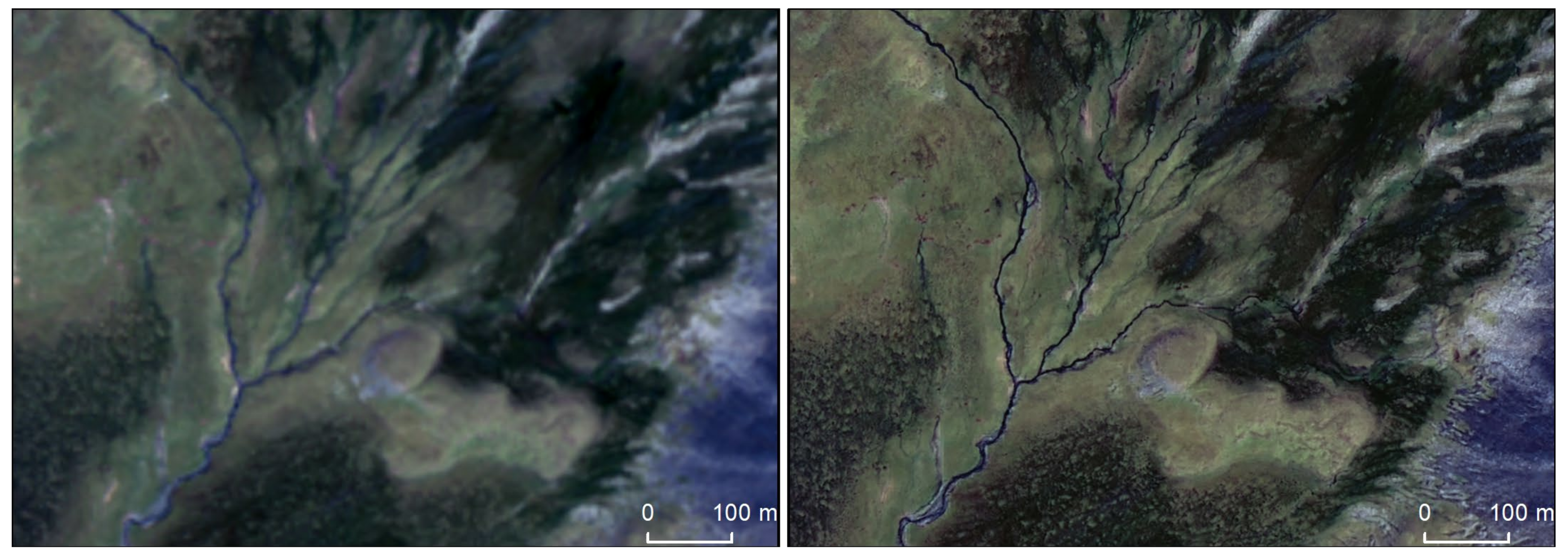
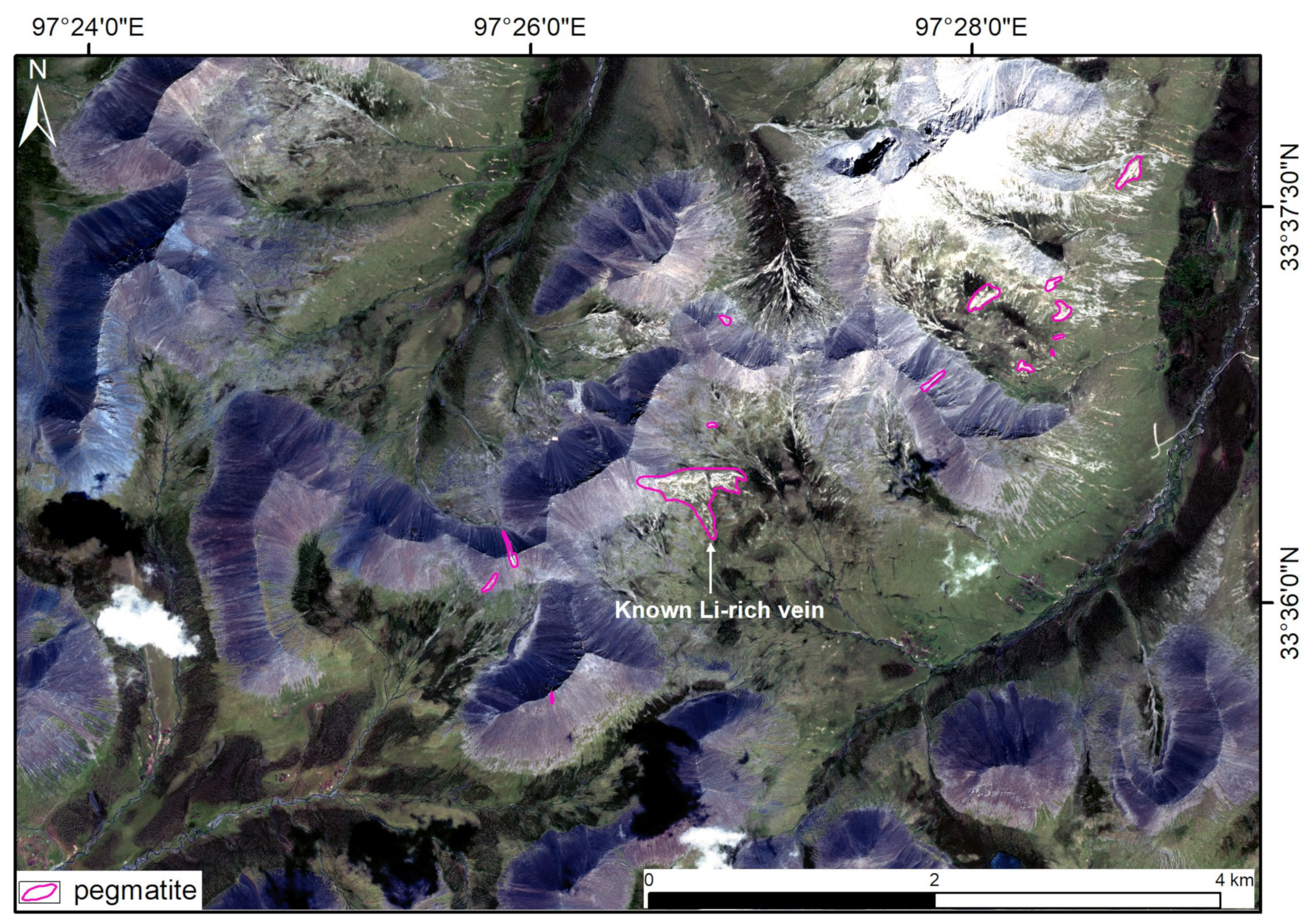
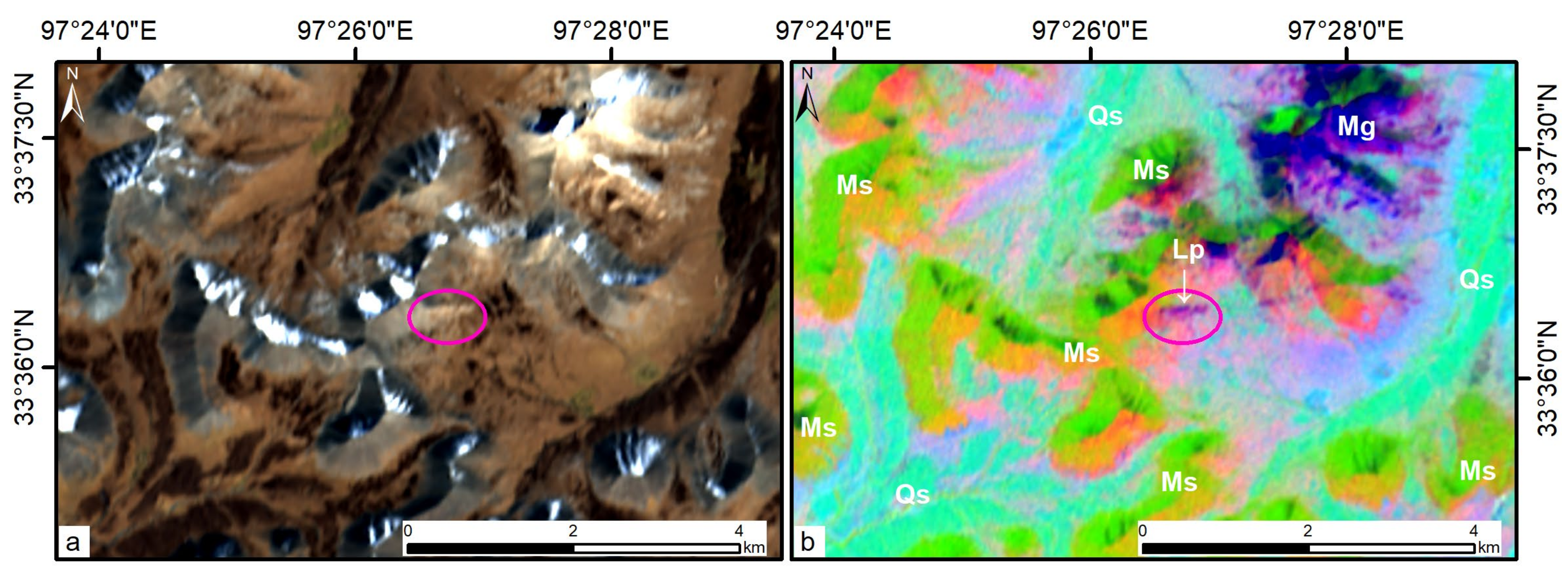
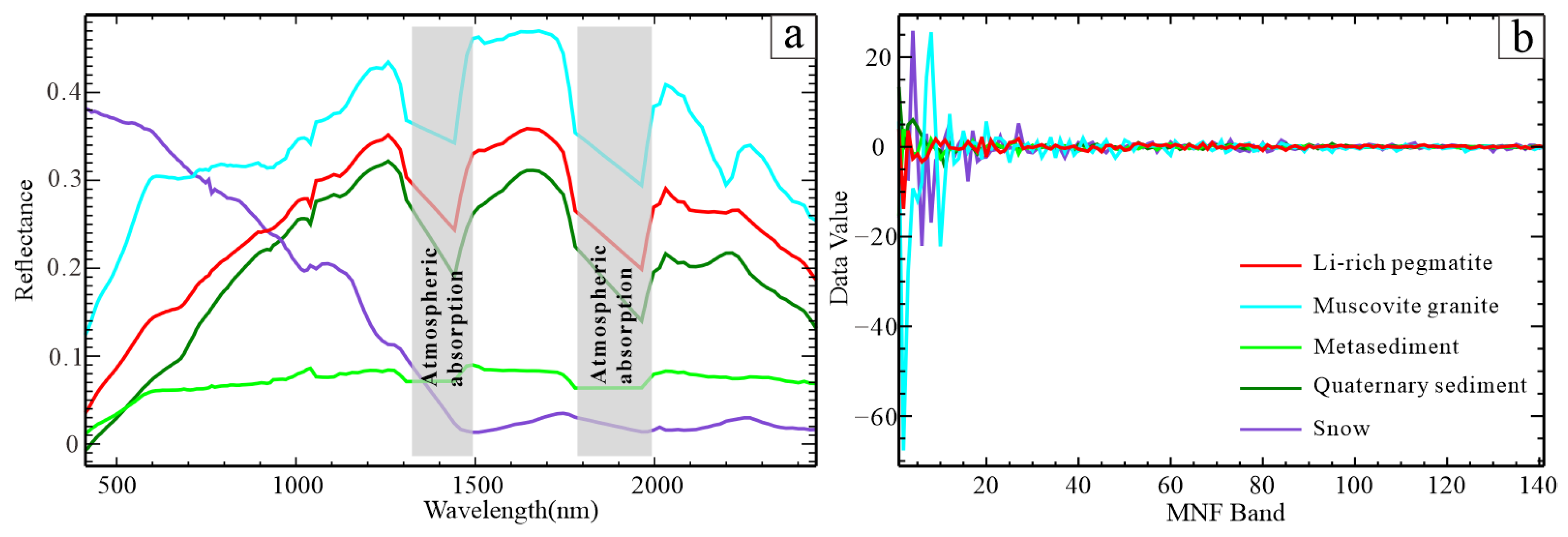
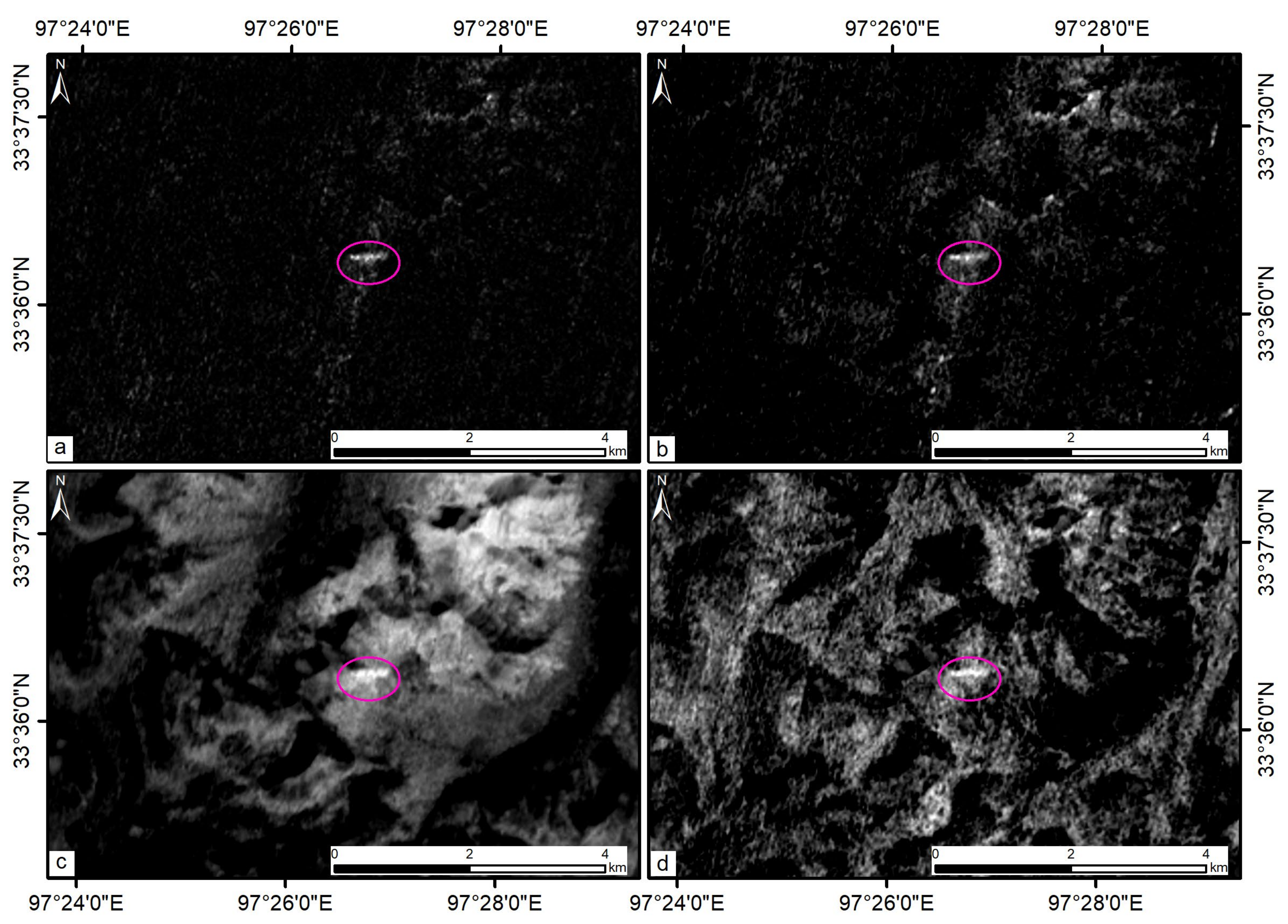
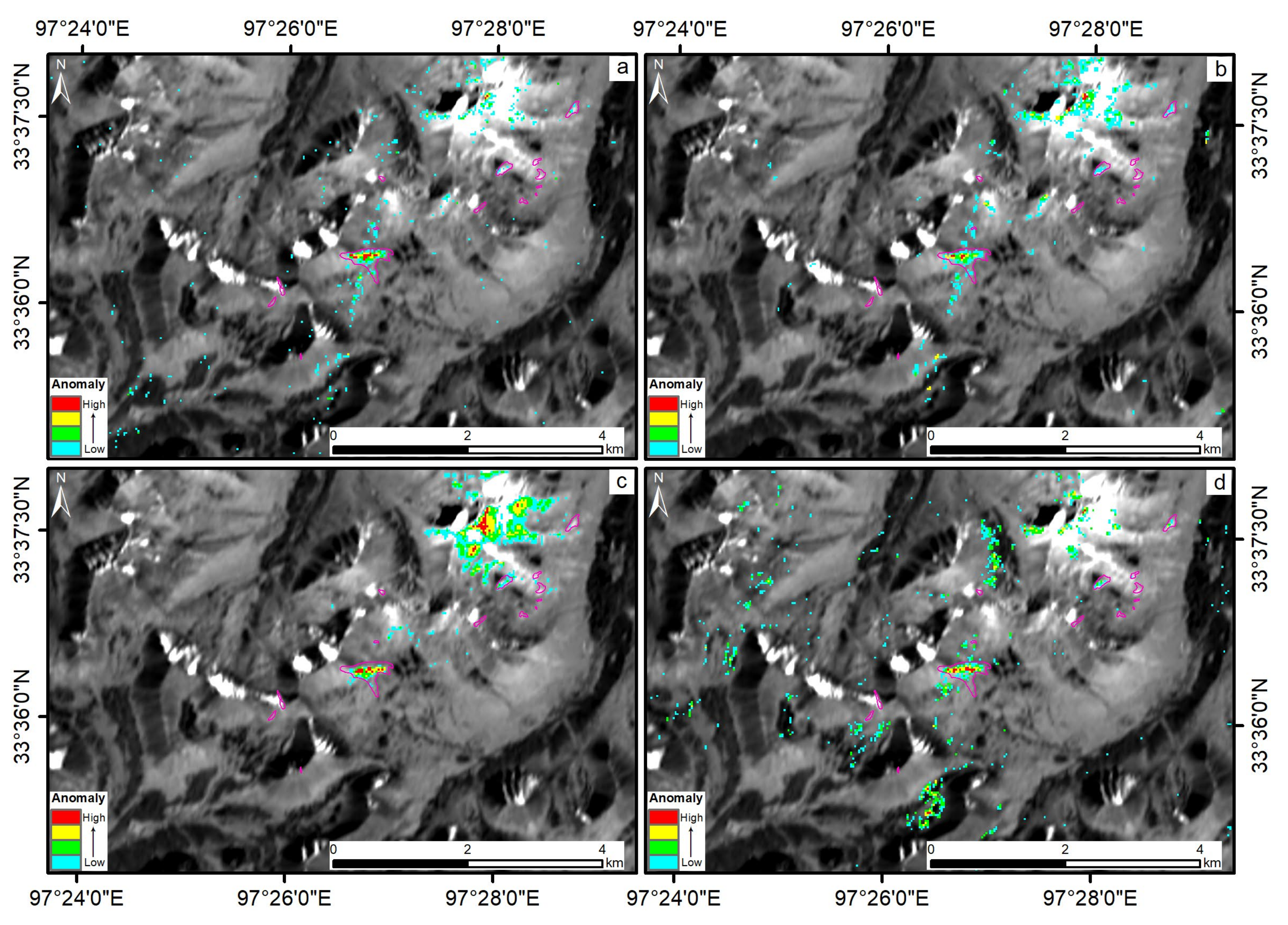
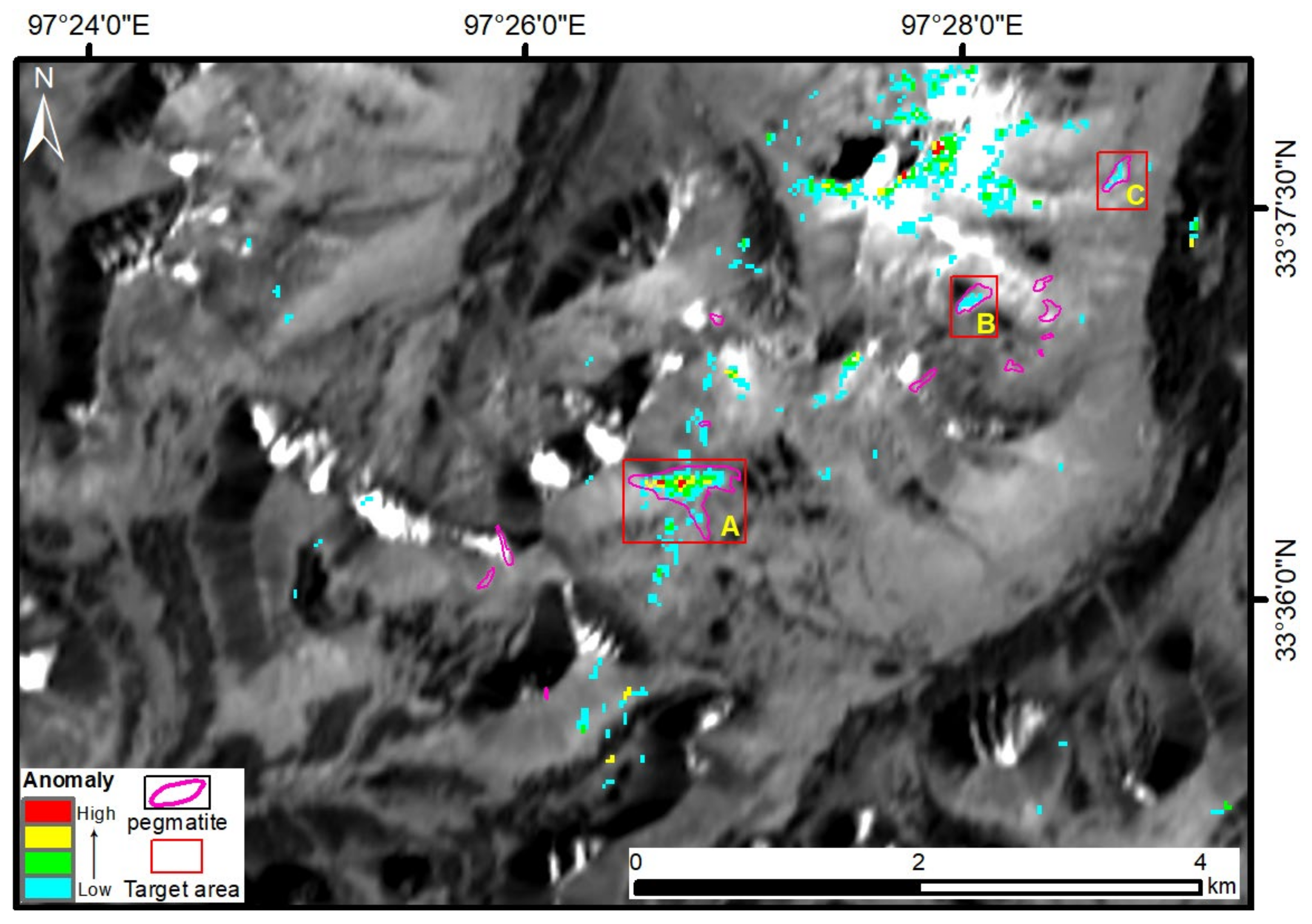

| Data | Spectral Range | Spectral Resolution | Pixel Size | Swath Width | |
|---|---|---|---|---|---|
| GF-2 | PAN | 0.45–0.90 μm | - | 1 m | 45 km |
| Blue | 0.45–0.52 μm | - | 4 m | ||
| Green | 0.52–0.59 μm | - | |||
| Red | 0.63–0.69 μm | - | |||
| NIR | 0.77–0.89 μm | - | |||
| ZY1-02D | VINR | 395–1040 nm | 10 nm | 30 m | 60 km |
| SWIR | 1005–2510 nm | 20 nm | |||
| Lithology Units | Imagery Features | Spectra | Descriptions |
|---|---|---|---|
| Granite |  |  | High overall reflectivity and increasing from blue to near infrared band; gray to bright white, blocky, large area, concentrated distribution, and clear lithology boundary. |
| Pegmatite | 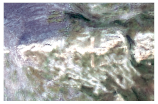 | 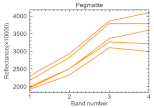 | Bright white with a high reflectivity, elongated and vein shape, usually small in area, occuring as dyke swarms with a certain direction, and a ridge-like landform due to its strong resistance to weathering. |
| Metasediment | 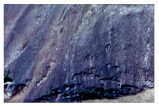 | 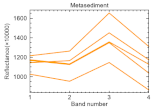 | Blue-gray, dark tone, low overall reflectivity, large distribution area, with bedding texture. |
| Quaternary sediment | 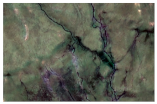 | 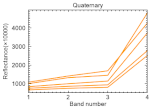 | The reflectivity is low in visible bands, but rises sharply in near infrared band. They fan out along both sides of the river and were often covered with meadows in grassy green. |
Disclaimer/Publisher’s Note: The statements, opinions and data contained in all publications are solely those of the individual author(s) and contributor(s) and not of MDPI and/or the editor(s). MDPI and/or the editor(s) disclaim responsibility for any injury to people or property resulting from any ideas, methods, instructions or products referred to in the content. |
© 2023 by the authors. Licensee MDPI, Basel, Switzerland. This article is an open access article distributed under the terms and conditions of the Creative Commons Attribution (CC BY) license (https://creativecommons.org/licenses/by/4.0/).
Share and Cite
Ding, W.; Ding, L.; Li, Q.; Li, J.; Zhang, L. Lithium-Rich Pegmatite Detection Integrating High-Resolution and Hyperspectral Satellite Data in Zhawulong Area, Western Sichuan, China. Remote Sens. 2023, 15, 3969. https://doi.org/10.3390/rs15163969
Ding W, Ding L, Li Q, Li J, Zhang L. Lithium-Rich Pegmatite Detection Integrating High-Resolution and Hyperspectral Satellite Data in Zhawulong Area, Western Sichuan, China. Remote Sensing. 2023; 15(16):3969. https://doi.org/10.3390/rs15163969
Chicago/Turabian StyleDing, Wenqing, Lin Ding, Qingting Li, Jinxiang Li, and Liyun Zhang. 2023. "Lithium-Rich Pegmatite Detection Integrating High-Resolution and Hyperspectral Satellite Data in Zhawulong Area, Western Sichuan, China" Remote Sensing 15, no. 16: 3969. https://doi.org/10.3390/rs15163969
APA StyleDing, W., Ding, L., Li, Q., Li, J., & Zhang, L. (2023). Lithium-Rich Pegmatite Detection Integrating High-Resolution and Hyperspectral Satellite Data in Zhawulong Area, Western Sichuan, China. Remote Sensing, 15(16), 3969. https://doi.org/10.3390/rs15163969






